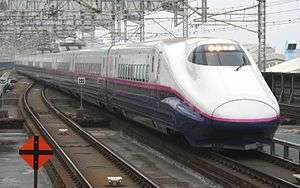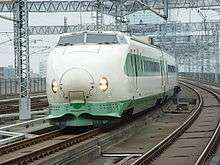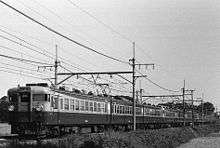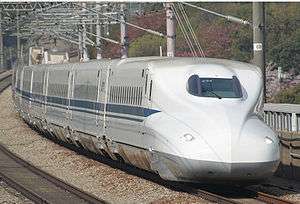Nasuno
The Nasuno (なすの) is a train service operated on the Tōhoku Shinkansen by East Japan Railway Company (JR East) in Japan.[1] It serves all stations between Tokyo and Kōriyama, a medium-sized city approximately 225 km north of Tokyo.[2]
 An E2 series trainset on a Nasuno service in February 2011 | |
| Overview | |
|---|---|
| Service type | Shinkansen |
| Locale | Tohoku Shinkansen |
| First service | 1959 (Semi-express) 1995 (Shinkansen) |
| Current operator(s) | JR East |
| Former operator(s) | JNR |
| Route | |
| Start | Tokyo |
| End | Kōriyama or Nasushiobara or Oyama |
| On-board services | |
| Class(es) | Standard + Green + Gran Class |
| Catering facilities | Trolley service |
| Technical | |
| Rolling stock | E2 series, E3 series, E5 series, E6 series, H5 series |
| Track gauge | 1,435 mm (4 ft 8 1⁄2 in) |
| Electrification | 25 kV AC overhead |
| Operating speed | 275 km/h (170 mph) |
Origin
The name Nasuno is derived from the Nasu Highlands (那須高原) and Nasu Onsen (那須温泉) areas located alongside the Tōhoku Shinkansen between Utsunomiya and Kōriyama.
Operations
There are approximately 16 return Nasuno trains daily, starting/terminating either at Oyama, Nasushiobara, or Kōriyama. Nasuno services stop at all stations en route. Double-decker Nasuno services formed of E4 series sets also operated up until September 2012, named Max Nasuno.
Rolling stock
- E2 series (10 cars)
- E2 series + E3 series (10+6 car) or (10+7 car)
- E5 series (10 cars)
- E5 series + E3 series (10+6 car) (since 17 March 2012)[3]
- E5 series + E6 series (10+7 car) (since April 2014)
- H5 series (10 cars) (since 26 March 2016)[4]
- H5 series + E6 series (10+7 car) (since 26 March 2016)[4]
 E2 series
E2 series- E3 series
- E5 series
 E6 series
E6 series- H5 series
Past
- 200 series (until 19 November 2011)[5]
- E1 series (12-car) (Max Nasuno)[6]
- E4 series (8+8-car) (Max Nasuno) (until September 2012)
- E4 series + E3 series (8+7 car) (until September 2012)
 A 200 series set on a Nasuno service in June 2002
A 200 series set on a Nasuno service in June 2002
History

The name Nasuno was first introduced on 22 September 1959 for semi-express (準急, junkyū) services operating between Ueno in Tokyo and Kuroiso on the Tōhoku Main Line. In 1966, this was upgraded to become an express (急行, kyūkō), and on 14 March 1985, it was upgraded to become a Limited express using 185 series EMU rolling stock. From 10 March 1990, the train was rerouted to operate between Shinjuku in Tokyo and Kuroiso.[7]
On 10 December 1995, the name was adopted for the new all-stations services on the Tōhoku Shinkansen.[1] The Tōhoku Main Line services to and from Shinjuku were renamed Ohayō Tochigi and Hometown Tochigi from this date. Prior to 1995, Aoba services formed the all-stations services along the whole line. However, with the introduction of short-distance Nasuno services, Aoba services were reduced, and in 1997, discontinued altogether, with the local services covered by Nasuno as far as Kōriyama, and all further stations served by the Yamabiko.
References
- JR新幹線&特急列車ファイル [JR Shinkansen & Limited Express Train File]. Japan: Kōtsū Shimbun. 2008. ISBN 978-4-330-00608-6.
- JR Timetable, December 2008
- 2012年3月ダイヤ改正について [March 2012 Timetable Revision] (PDF) (in Japanese). Japan: East Japan Railway Company. 16 December 2011. Retrieved 16 December 2011.
- JR時刻表 [JR Timetable] (in Japanese). Japan: Kotsu Shimbunsha. 2016. p. 979. EAN 4910053110464.
- Ito, Hisami (December 2011). "復活 ! "はやぶさ",東北新幹線" [Return of the Tohoku Shinkansen Hayabusa!]. Japan Railfan Magazine. Vol. 51 no. 608. Japan: Kōyūsha Co., Ltd. p. 17.
- JR電車編成表 '98夏号 [JR EMU Formations - Summer 1998]. Japan: JRR. July 1998. p. 6. ISBN 4-88283-029-9.
- 列車名鑑1995 [Train Name Directory 1995]. Japan: Railway Journal. August 1995.
External links
| Wikimedia Commons has media related to Nasuno (Shinkansen). |
- E2 series Hayate/Yamabiko/Nasuno (in Japanese)


.svg.png)